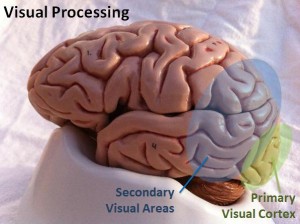Social signals, how do we understand them?
The linked study looked specifically at regions of the brain that are involved in processing social rewards. The information on this page describes these social circuits. Note that the cues provided in this study were visual (images of coins or happy faces) and vision is here describes as the primary social sense.
You observe the world around you at birth, and without conscious effort, your brain places value on social experience. Most people use vision as the main source of social information, but touch, smell, and sound also provide cues. Somehow, your brain processes social signals and figures out what is important for you to know. 
Visual Social Signals
Specialized brain areas work together to attach meaning to social signals and guide your social behavior. For example, two key brain parts involved in social visual information are in the back and on the sides of your brain. They are called the primary and secondary cortical sensory areas. These areas focus on visual objects that have social meaning, such as someone’s face.
Early on, babies pay close attention to the face. Given a choice between a face and another object, babies spend more time looking at the face. Eye-tracking experiments show that babies pay attention first to the eyes, followed by the mouth. When a person looks into the eyes of a baby, the baby looks back. When a person smiles, a baby smiles too.
Joint Attention Example
These are simple examples, but you use social signals for complex social behavior too. Joint attention is a form of social behavior based on shared focus. Imagine a mom and a toddler playing at the beach in the sand. The mom turns her gaze to a crab crawling quickly toward the toddler. The toddler’s brain processes the mom’s gaze. In response, the toddler looks in the same direction as the mom looks, just in time to scoot away from the crab!
The answer to how we understand social signals is not simple. This section offers a brief introduction to the role social signals play in your life. But to learn more about how the brain uses social cues, please visit our next page on key parts of your social brain!

